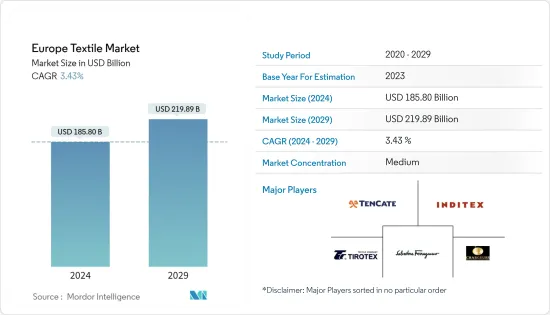PUBLISHER: Mordor Intelligence | PRODUCT CODE: 1433859

PUBLISHER: Mordor Intelligence | PRODUCT CODE: 1433859
Europe Textile - Market Share Analysis, Industry Trends & Statistics, Growth Forecasts (2024 - 2029)
The Europe Textile Market size is estimated at USD 185.80 billion in 2024, and is expected to reach USD 219.89 billion by 2029, growing at a CAGR of 3.43% during the forecast period (2024-2029).

In Europe, the textile industry significantly contributes to the economy, employing nearly 6% of the working class in total manufacturing. After COVID-19, there was an inclination toward the latest fashion trends among the young generation. Changing collections every three weeks has induced consumers to act with new behavior.
Digital platforms and digital marketing strategies are becoming prevalent in the European fashion market, and many new brands have emerged with the development of e-commerce, which allows companies to engage consumers through virtual reality. The fashion and online apparel industry is the one that marks the most significant growth in e-commerce sales. Therefore, the advent of online platforms has increased consumer spending on clothing through these channels, driving sales and revenue in the European textile market.
Europe Textile Market Trends
Rise in the Demand for Organic Textiles and Fabrics
Organic clothing is available in cotton, jute, silk, kapok, hemp, or wool. The demand for organic clothing is rising as more and more consumers become concerned about the environment. The European Textile sector is especially proactive in undertaking research work to develop new and innovative products. Given the health and environmental benefits of organic products, more eco-conscious consumers are now shifting towards clothing made from organic textiles. In response to consumer demand and pressure to green its operations, the fashion industry is taking new strides towards using more sustainable fabrics. Fast fashion giants are also leaping organic and recycled alternatives. H&M, for instance, has already increased its use of organic and recycled cotton to 95%.
Rising Changes in Consumer's Shopping Behavior
The growth in disposable income and the increasing preference for online shopping will drive the European textile market for the next few years. Online shopping is still growing in importance, although take-up varies significantly by region and country. About 5 % of European household expenditure is spent on clothing and footwear, of which about 80 % is spent on clothes and 20 % on footwear. Furthermore, increasing disposable has led to a rise in supermarkets and retail stores, thereby driving the overall market growth. The demand is very high for premium and branded products due to increasing per capita disposable income. Rising disposable income, along with investments in textile manufacturing, would create lucrative growth prospects for the Textile market across the region.
Europe Textile Industry Overview
Europe is home to hundreds of leading retailers and brands, internationally acclaimed designers, thousands of talented emerging designers, and forward-thinking entrepreneurs, researchers, and educators. European high-quality textiles and premium fashion products are in growing demand, both in high-income countries such as the United, Switzerland, Japan, and Canada, but also in emerging countries such as China and Hong Kong, Russia, Turkey, and the Middle East. Technical textiles are an undisputed success story of the European industry. In terms of international trade, both exports and imports of technical textiles have grown continuously over the years. Major players in the textile industry of Europe are Salvatore Ferragamo SpA, Koninklijke Ten Cate NV, Inditex, Tirotex, and Chargeurs SA.
Additional Benefits:
- The market estimate (ME) sheet in Excel format
- 3 months of analyst support
TABLE OF CONTENTS
1 INTRODUCTION
- 1.1 Study Assumptions and Market Definition
- 1.2 Scope of the Study
2 RESEARCH METHODOLOGY
3 EXECUTIVE SUMMARY
4 MARKET INSIGHTS AND DYNAMICS
- 4.1 Market Overview
- 4.2 Market Drivers
- 4.2.1 Growing Awareness of the Latest Fashion Trends Among the Young Generation
- 4.3 Market Restraints
- 4.3.1 High Wastage
- 4.3.2 Market Opportunities
- 4.3.2.1 Increasing Trend of Smart Textiles
- 4.4 Value Chain / Supply Chain Analysis
- 4.5 Porter's Five Forces Analysis
- 4.5.1 Bargaining Power of Suppliers
- 4.5.2 Bargaining Power of Buyers/Consumers
- 4.5.3 Threat of New Entrants
- 4.5.4 Threat of Substitute Products
- 4.5.5 Intensity of Competitive Rivalry
- 4.6 Impact of COVID-19 on the Market
- 4.7 Insights on Latest Technologies Used in the Industry
5 MARKET SEGMENTATION
- 5.1 Application
- 5.1.1 Clothing
- 5.1.2 Industrial/Technical Applications
- 5.1.3 Household Applications
- 5.2 Material Type
- 5.2.1 Cotton
- 5.2.2 Jute
- 5.2.3 Silk
- 5.2.4 Synthetics
- 5.2.5 Wool
- 5.3 Process
- 5.3.1 Woven
- 5.3.2 Non-woven
6 COMPETITIVE LANDSCAPE
- 6.1 Market Concentration Overview
- 6.2 Company Profiles
- 6.2.1 Salvatore Ferragamo SpA
- 6.2.2 Koninklijke Ten Cate NV
- 6.2.3 Inditex
- 6.2.4 Tirotex
- 6.2.5 Chargeurs SA
- 6.2.6 Zorlu Holding
- 6.2.7 Miroglio Spa
- 6.2.8 Aquafilslo S.p.a.
- 6.2.9 Getzner Textil Aktiengesellschaft
- 6.2.10 Fulgar SpA*
7 MARKET FUTURE TRENDS
8 DISCLAIMER




